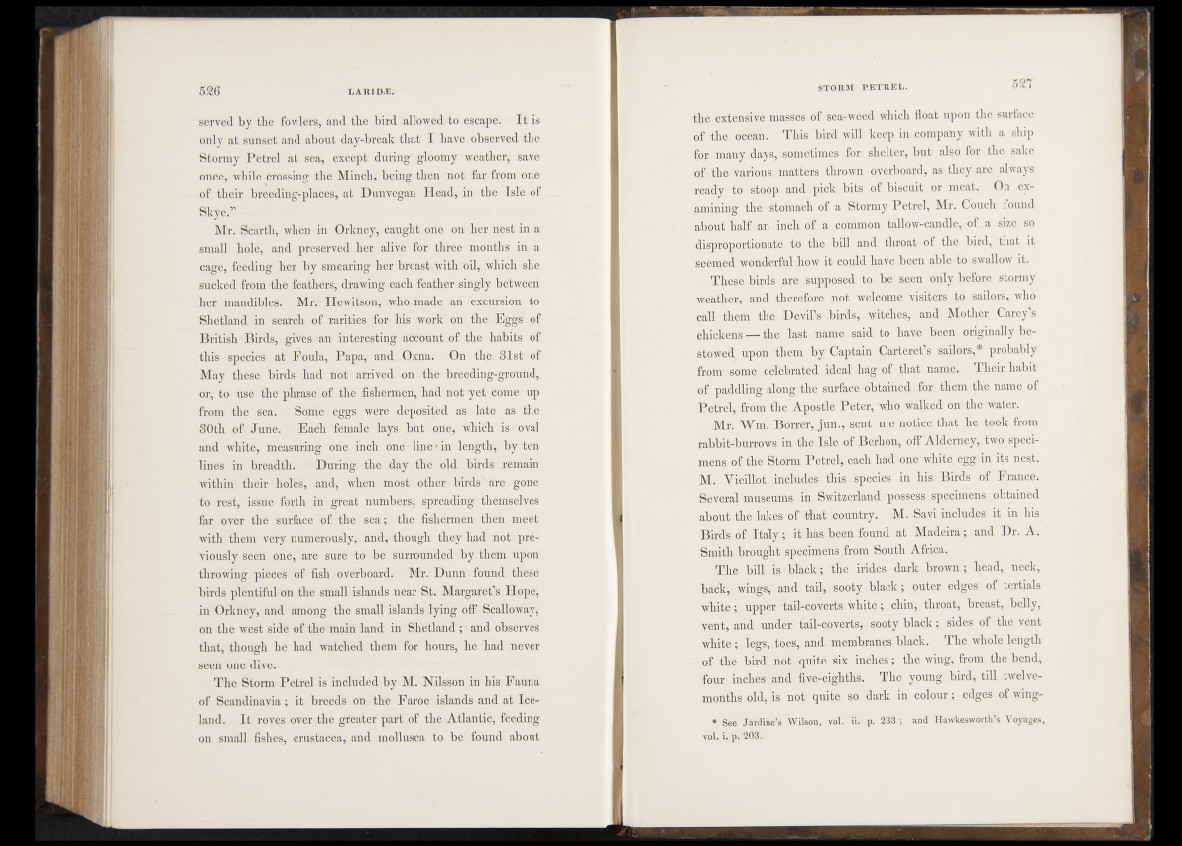
served by the fowlers, and the bird allowed to escape. I t is
only at sunset and about day-break that I have observed the
Stormy Petrel at sea, except during-gloomy weather, save
once, while crossing the Minch, being then not far from one
of their breeding-places, at Dunvegan Head, in -the Isle of
Skye.” 4
Mr. Scarth, when .in Orkney, caught one on her nest in a
small hole, and preserved her alive for three , months in a
cage, feeding her by smearing her breast with'oil, which she
sucked from the feathers, drawing each feather singly between
her mandibles. Mr. Hewitson, who.made an excursion to
Shetland in search of rarities for his work on the Eggi-of
British Birds, givfes an interesting account of the habits of
this species at Poula, Papa, and Oxna. On the 31st of
May these birds had not arrived on-the breeding-ground,'
or, to: use the phrase of the fishermen, had not yet come up
from the sea. Some' eggs were deposited as late as the
30th of June. Each female lays but one, which is oval
and white, measuring one inch one line-in length, by ten
lines in breadth. During the day the’ old birds remain
within their holes, and, when most other birdsHre gone.
to rest, issue forth , in great numbers, spreading themselves
far over the surface of the sea; the fishermen then meet
with them very numerously, and, though they had not previously
seen one, are surè to be surrounded by them upon
throwing pieces of fish overboard» Mr. Dunn found these
birds plentiful on the small islands near St. Margaret’s Hope,
in Orkney, and among the small islands lying off Scalloway,
on the wést side of the main land in Shetland ; and observes
that, though he had watched them for hours, he had never
seen one dive.
The Storm Petrel is included by M. Nilsson in Ills Fauna
of Scandinavia; it breeds on the Faroe islands and at Iceland.
I t roves over the greater part of the Atlantic, feeding
on small fishes, Crustacea, and mollusca to be found about
the extensive masses of sea-weed which float upon the surface
of the ocean. This bird will keep in company with a ship
for many days, sometimes for, shelter, but also for the sake
<ff the various, matters thrown overboard, as they are always
ready to stoop and pick bits of biscuit or meat. On examining
the stomach of a Stormy Petrel, Mr.- Couch found
about half an inch .of a common tallow-candle,- of a size so
disproportionate, to the bill and throat of the bird, that it
seemed wonderful how it could have been able to swallow it.
These birds are supposed to ^ be, seen only before stormy
weather, and therefore not welcome-“ visiters to sailors, who
call thgm Devil’s, birds,, pitches,- and Mother Carey’s
chickens — the last name said to have' been originally bestowed
upon them by Captain Carteret’s sailors,* probably
from some celebrated ideal hag of that name. Their habit
of paddling along the surface;obtained for them the name of
Petrel, from the Apostle Peter, who walked on the water.
Mr. Wm. Borrer, jun., sent me notice that he took from
rabbit-burrows in the:Isle, of Berhon, off Alderney, two specimens
of the Storm Petrel, each had one white hgg in its nest.
M. Vieillot itfcludes this, species in his Birds of France.
Several museums in Sw itz e rla n d -possess specimens obtained
about the lakes of. that çbuntry. M. Savi includes it in his
Birds of Italy ; it has been found at Madeira ; and Dr. A.
Smith brought specimens from South Africa. ;
The bill is black; the frides dark brown ; head, neck,
back, wings, and tail, sooty black ; outer edges of tertials
white ; upper tail-coverts white ; chin, throat, breast, belly,
, vent, and under tail-coverts, sooty black; sides of the vent
white ; legs, toes, and membranes black. The whole length
- of the bird not/quite six inches; the wing, from the bend,
four inches and five-eighths. The young bird, tiff twelve-
months old, is not quite so dark in colour ; edges of wing-
» See Jarditte’s Wilson, vol. ii. p. 283 ; and Hawkesworth’s Voyages,
vol. i. p. 203.